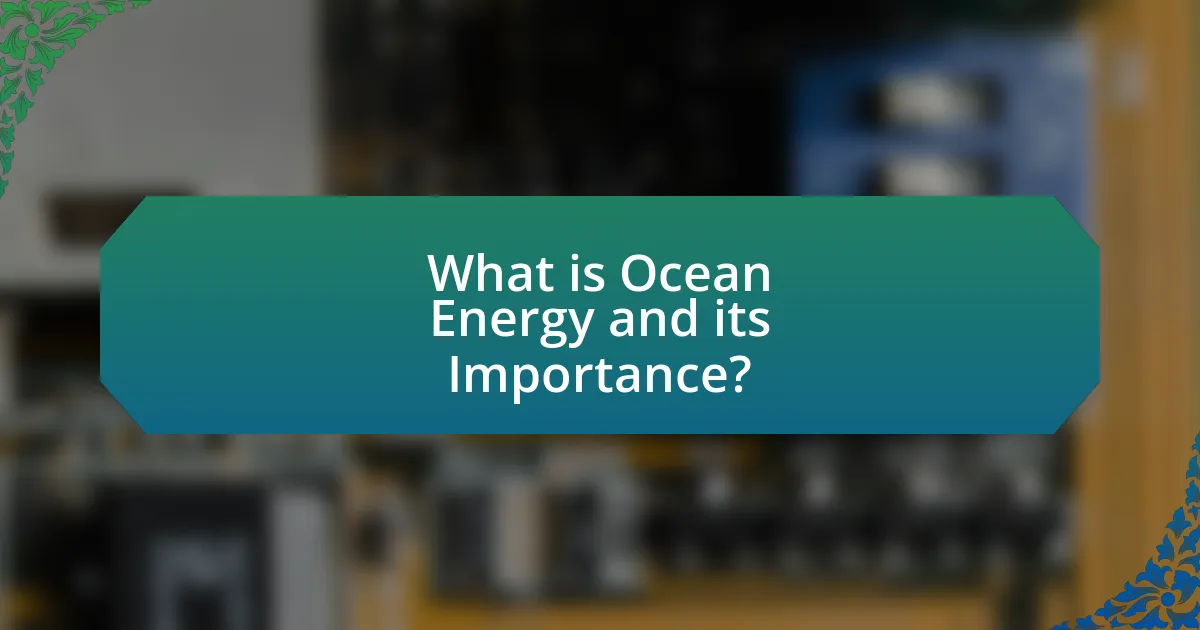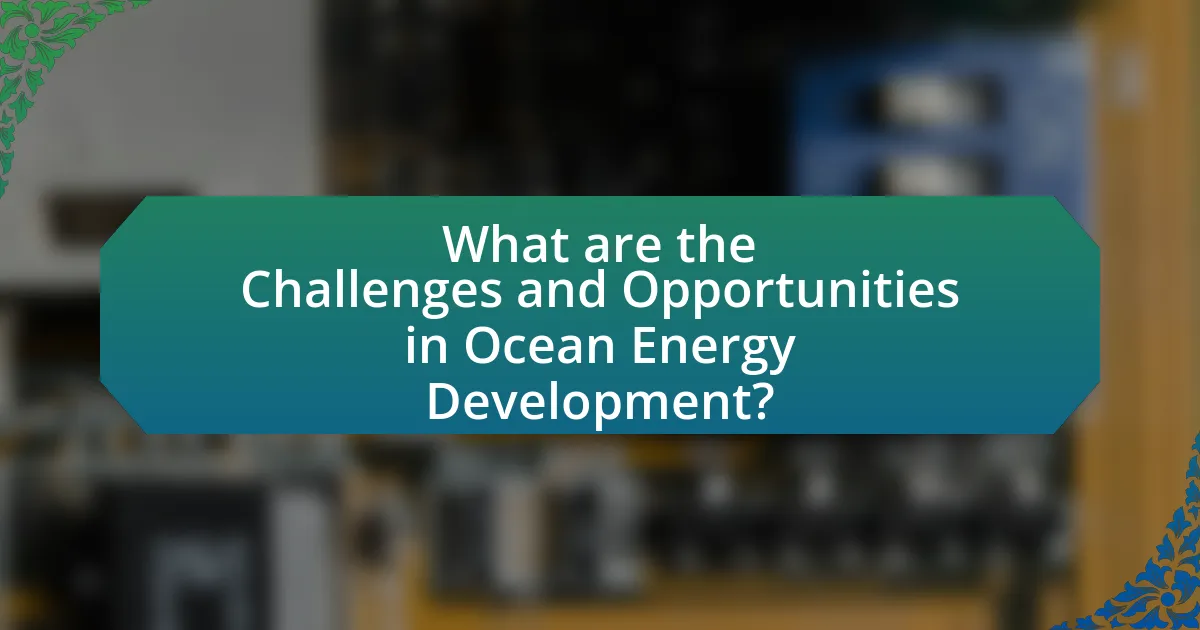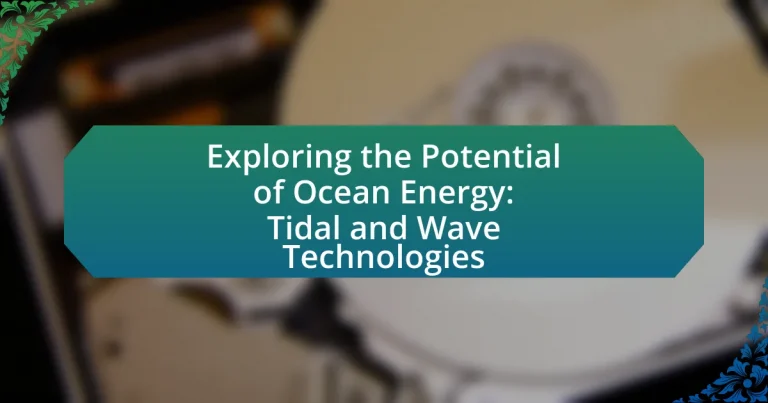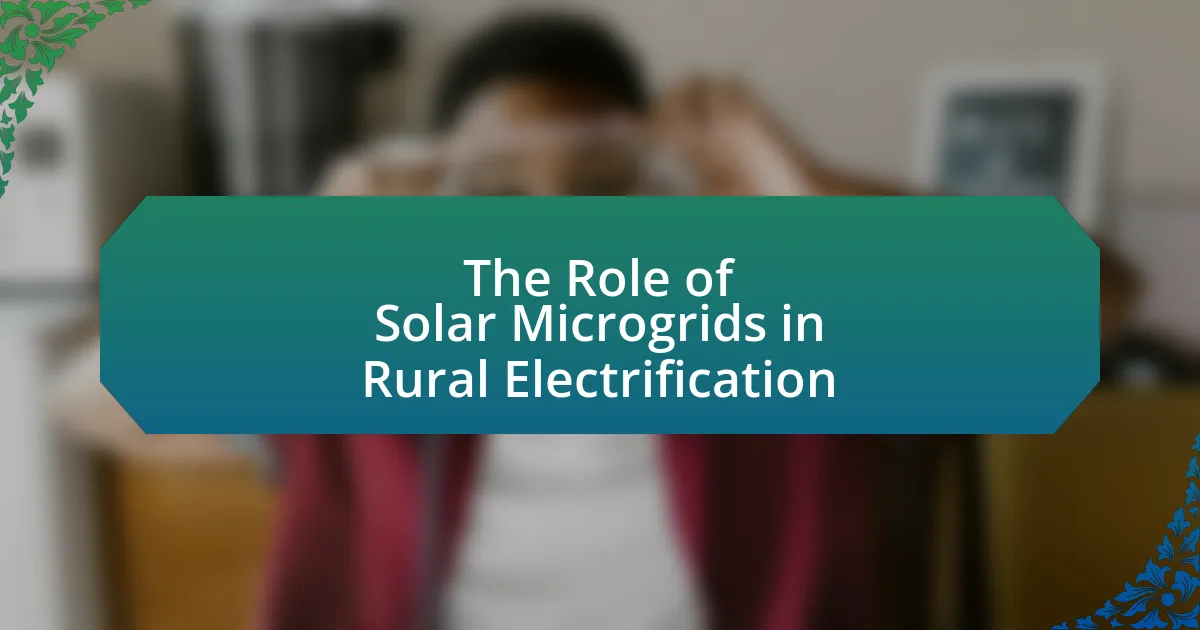Ocean energy, derived from the ocean’s natural processes such as tidal movements and wave action, presents a significant opportunity for sustainable energy generation. This article explores the various technologies associated with tidal and wave energy, detailing their operational principles, environmental benefits, and potential to reduce greenhouse gas emissions. It also addresses the challenges and opportunities in ocean energy development, including economic barriers, technological advancements, and the role of government policies. Key types of tidal and wave technologies, such as tidal stream systems and point absorbers, are examined, highlighting their contributions to renewable energy solutions and the importance of effective stakeholder collaboration in project implementation.

What is Ocean Energy and its Importance?
Ocean energy refers to the renewable energy derived from the ocean’s natural processes, including tidal movements, wave action, and thermal gradients. Its importance lies in its potential to provide a sustainable and significant source of clean energy, which can help reduce reliance on fossil fuels and mitigate climate change. According to the International Energy Agency, ocean energy has the capacity to generate over 20,000 terawatt-hours of electricity annually, which could meet a substantial portion of global energy demands. This makes ocean energy a crucial component in the transition to a low-carbon energy future.
How do tidal and wave technologies fit into the broader category of ocean energy?
Tidal and wave technologies are integral components of the broader category of ocean energy, which encompasses all forms of energy derived from oceanic sources. These technologies harness the kinetic and potential energy generated by ocean tides and surface waves, respectively, to produce renewable electricity. According to the International Energy Agency, ocean energy has the potential to provide up to 337 gigawatts of power globally, with tidal and wave energy contributing significantly to this capacity. Tidal energy exploits the gravitational pull of the moon and sun, while wave energy captures the movement of surface waves, both of which are predictable and consistent compared to other renewable sources.
What are the fundamental principles behind tidal energy generation?
Tidal energy generation is fundamentally based on the gravitational forces exerted by the moon and the sun on Earth’s oceans, which create tidal movements. These movements result in the rise and fall of sea levels, known as tides, which can be harnessed to produce electricity. The process typically involves the use of tidal turbines or barrages that convert the kinetic and potential energy of moving water into mechanical energy, which is then transformed into electrical energy.
For instance, the La Rance Tidal Power Station in France, operational since 1966, utilizes a barrage system to generate approximately 240 MW of power, demonstrating the viability of this energy source. The predictability of tidal patterns, occurring roughly every six hours, further enhances the reliability of tidal energy as a renewable resource.
What are the fundamental principles behind wave energy generation?
Wave energy generation fundamentally relies on the conversion of the kinetic and potential energy of ocean waves into usable electrical energy. This process typically involves the use of devices such as point absorbers, oscillating water columns, and overtopping devices, which capture the movement of waves. For instance, point absorbers float on the surface and move with the waves, converting mechanical motion into electrical energy through hydraulic systems or generators. The effectiveness of wave energy generation is supported by the fact that ocean waves can carry significant energy, with estimates suggesting that the global potential for wave energy is around 2 terawatts, enough to power millions of homes.
Why is ocean energy considered a sustainable energy source?
Ocean energy is considered a sustainable energy source because it harnesses the natural and continuous movement of ocean tides and waves, which are inexhaustible resources. Unlike fossil fuels, ocean energy does not deplete over time and has a minimal environmental impact, as it produces little to no greenhouse gas emissions during operation. According to the International Energy Agency, ocean energy has the potential to provide a significant portion of the world’s energy needs, with estimates suggesting that it could generate up to 10% of global electricity by 2050. This capacity for large-scale energy production, combined with its renewable nature, solidifies ocean energy’s status as a sustainable energy source.
What environmental benefits does ocean energy provide compared to fossil fuels?
Ocean energy provides significant environmental benefits compared to fossil fuels, primarily by reducing greenhouse gas emissions and minimizing ecological disruption. Unlike fossil fuels, which release carbon dioxide and other pollutants into the atmosphere, ocean energy harnesses natural processes such as tides and waves without emitting harmful gases. For instance, a study by the International Energy Agency indicates that transitioning to ocean energy could reduce global CO2 emissions by up to 4 billion tons annually by 2040. Additionally, ocean energy systems typically have a smaller physical footprint and lower impact on marine ecosystems compared to fossil fuel extraction and combustion, which often lead to habitat destruction and oil spills.
How does ocean energy contribute to reducing greenhouse gas emissions?
Ocean energy contributes to reducing greenhouse gas emissions by providing a renewable energy source that displaces fossil fuel use. Tidal and wave energy technologies harness the natural movement of water to generate electricity without emitting carbon dioxide or other greenhouse gases. For instance, a study by the International Energy Agency indicates that ocean energy could potentially supply up to 10% of global electricity demand by 2050, significantly lowering reliance on carbon-intensive energy sources. This transition to ocean energy not only mitigates emissions but also supports sustainable energy development.

What are the Different Types of Tidal and Wave Technologies?
The different types of tidal and wave technologies include tidal stream systems, tidal range systems, oscillating water columns, point absorbers, and overtopping devices. Tidal stream systems harness kinetic energy from moving water, while tidal range systems utilize the potential energy from the difference in water levels between high and low tides. Oscillating water columns capture energy from wave motion, point absorbers convert the energy of waves into mechanical power, and overtopping devices collect water from waves to generate electricity. These technologies are designed to exploit the predictable nature of tides and the energy of ocean waves, contributing to renewable energy solutions.
What are the main types of tidal energy technologies?
The main types of tidal energy technologies are tidal stream systems, tidal range systems, and tidal lagoons. Tidal stream systems utilize underwater turbines to capture the kinetic energy of moving water, while tidal range systems exploit the difference in water levels between high and low tides to generate electricity, often using barrages. Tidal lagoons are similar to tidal range systems but are enclosed bodies of water that harness tidal energy through turbines placed in the lagoon walls. These technologies are validated by various projects worldwide, such as the La Rance Tidal Power Station in France, which has been operational since 1966 and demonstrates the effectiveness of tidal range systems.
How do tidal stream generators operate?
Tidal stream generators operate by harnessing the kinetic energy of moving water caused by tidal currents. These generators typically consist of underwater turbines that rotate as water flows past them, converting the mechanical energy into electrical energy. The efficiency of tidal stream generators is supported by the predictable nature of tides, which can provide a consistent energy source. According to the International Energy Agency, tidal energy has the potential to generate up to 1,600 terawatt-hours of electricity annually, demonstrating its viability as a renewable energy source.
What are the advantages and disadvantages of tidal barrages?
Tidal barrages offer significant advantages and disadvantages. The primary advantage is their ability to generate renewable energy by harnessing tidal movements, which can provide a reliable and predictable energy source. For instance, the La Rance tidal power station in France has been operational since 1966, demonstrating the feasibility of tidal energy generation. Additionally, tidal barrages can help in flood control and create new habitats for wildlife.
Conversely, the disadvantages include high construction costs and potential environmental impacts. Building a tidal barrage can require substantial investment, often exceeding billions of dollars, as seen in projects like the Sihwa Lake Tidal Power Station in South Korea. Furthermore, tidal barrages can disrupt local ecosystems, affecting fish migration patterns and sediment transport, which can lead to ecological imbalances.
What are the main types of wave energy technologies?
The main types of wave energy technologies include point absorbers, oscillating water columns, and overtopping devices. Point absorbers are buoy-like structures that move with wave motion, converting kinetic energy into electricity. Oscillating water columns utilize the rise and fall of water levels to drive air through turbines, generating power. Overtopping devices capture incoming waves in a reservoir, allowing the water to flow back out through turbines to produce energy. These technologies are designed to harness the energy from ocean waves effectively, contributing to renewable energy solutions.
How do point absorbers work in wave energy conversion?
Point absorbers convert wave energy into usable energy by utilizing the relative motion between a floating buoy and a submerged structure. This motion is harnessed through mechanical systems that convert the kinetic energy of waves into electrical energy, typically using hydraulic or electrical generators. The buoy moves up and down with the waves, creating pressure changes that drive hydraulic fluids or generate electricity directly. Research indicates that point absorbers can achieve high efficiency in energy conversion, with some designs capable of converting over 80% of the wave energy into electrical power, making them a promising technology in the field of wave energy conversion.
What is the role of oscillating water columns in wave energy systems?
Oscillating water columns (OWCs) play a crucial role in wave energy systems by converting the kinetic energy of ocean waves into mechanical energy. This conversion occurs as waves enter the OWC chamber, causing the water level to rise and fall, which in turn creates an oscillating air column above the water. The movement of this air column drives a turbine connected to a generator, thus producing electricity. OWCs are particularly effective because they can operate in various sea conditions and are designed to harness energy from both incoming and outgoing waves, maximizing energy capture.

What are the Challenges and Opportunities in Ocean Energy Development?
The challenges in ocean energy development include high capital costs, technological limitations, environmental impacts, and regulatory hurdles. High capital costs are a significant barrier, with estimates indicating that offshore wind projects can require investments exceeding $6 million per megawatt. Technological limitations arise from the need for advanced materials and systems to withstand harsh marine environments, which can hinder efficiency and reliability. Environmental impacts, such as effects on marine ecosystems and navigation, necessitate thorough assessments and can delay project approvals. Regulatory hurdles involve complex permitting processes that vary by region, often leading to increased project timelines and costs.
Conversely, opportunities in ocean energy development are substantial, driven by the growing demand for renewable energy and advancements in technology. The global ocean energy market is projected to reach $29 billion by 2025, highlighting the economic potential. Innovations in tidal and wave energy technologies, such as improved turbine designs and energy storage solutions, can enhance efficiency and reduce costs. Additionally, ocean energy can provide a consistent and predictable energy source, addressing intermittency issues faced by other renewables like solar and wind. The integration of ocean energy into national grids can also contribute to energy security and reduce reliance on fossil fuels.
What are the main technical challenges facing tidal and wave energy technologies?
The main technical challenges facing tidal and wave energy technologies include high capital costs, environmental impacts, and reliability of energy generation. High capital costs arise from the need for robust infrastructure capable of withstanding harsh marine conditions, which can deter investment. Environmental impacts involve potential disruptions to marine ecosystems, necessitating thorough assessments and mitigation strategies. Reliability of energy generation is affected by the variability of tidal and wave patterns, making it essential to develop efficient energy storage solutions and grid integration methods. These challenges are supported by studies indicating that overcoming these barriers is crucial for the widespread adoption of ocean energy technologies.
How do environmental impacts affect the deployment of ocean energy systems?
Environmental impacts significantly influence the deployment of ocean energy systems by necessitating thorough assessments and regulatory compliance. These systems, including tidal and wave energy technologies, must evaluate potential effects on marine ecosystems, such as alterations in habitat, changes in water quality, and impacts on local wildlife. For instance, studies have shown that the installation of tidal turbines can affect fish migration patterns and disrupt benthic habitats, leading to stricter environmental regulations and permitting processes. Consequently, developers must invest time and resources in environmental impact assessments to mitigate adverse effects, which can delay project timelines and increase costs.
What are the economic barriers to the widespread adoption of ocean energy?
The economic barriers to the widespread adoption of ocean energy include high initial capital costs, limited financial incentives, and uncertain return on investment. High initial capital costs arise from the advanced technology and infrastructure required for ocean energy projects, which can deter investors. Limited financial incentives, such as insufficient government subsidies or tax breaks, further hinder investment in ocean energy compared to more established renewable sources like wind and solar. Additionally, the uncertain return on investment is influenced by the nascent stage of ocean energy technology, which leads to perceived risks among investors, making it challenging to secure funding for large-scale projects.
What opportunities exist for innovation in ocean energy technologies?
Opportunities for innovation in ocean energy technologies include advancements in tidal and wave energy conversion systems, enhanced energy storage solutions, and improved materials for durability and efficiency. Tidal energy systems can benefit from innovations in turbine design, which can increase energy capture efficiency by up to 30%, as demonstrated by recent projects in the UK. Wave energy technologies can explore new designs, such as point absorbers and oscillating water columns, which have shown potential for higher energy output in various sea conditions. Additionally, integrating artificial intelligence for predictive maintenance and optimizing energy management systems can significantly enhance operational efficiency. These innovations are crucial as the global ocean energy market is projected to reach $29 billion by 2026, highlighting the economic potential of these technologies.
How can advancements in materials science improve ocean energy systems?
Advancements in materials science can significantly improve ocean energy systems by developing more durable and efficient materials that withstand harsh marine environments. For instance, the introduction of corrosion-resistant alloys and advanced composites can enhance the longevity and performance of tidal and wave energy devices. Research indicates that materials like carbon fiber reinforced polymers can reduce weight while increasing strength, leading to more efficient energy capture and lower maintenance costs. Additionally, innovations in nanotechnology can lead to coatings that minimize biofouling, thereby improving the operational efficiency of ocean energy systems. These advancements not only optimize energy production but also contribute to the sustainability and economic viability of ocean energy technologies.
What role do government policies play in promoting ocean energy development?
Government policies play a crucial role in promoting ocean energy development by providing regulatory frameworks, financial incentives, and research funding. These policies facilitate the establishment of standards and guidelines that ensure safe and efficient deployment of tidal and wave energy technologies. For instance, countries like the United Kingdom have implemented feed-in tariffs and renewable energy certificates, which encourage investment in ocean energy projects by guaranteeing fixed payments for energy produced. Additionally, government funding for research and development, such as the U.S. Department of Energy’s Water Power Technologies Office, supports innovation and reduces the costs associated with ocean energy technologies. These combined efforts create a favorable environment for the growth of the ocean energy sector, ultimately leading to increased adoption and technological advancements.
What are the best practices for implementing tidal and wave energy projects?
The best practices for implementing tidal and wave energy projects include conducting thorough site assessments, engaging stakeholders early, ensuring compliance with environmental regulations, and utilizing advanced technology for energy conversion. Site assessments are crucial as they identify optimal locations based on tidal patterns and wave energy potential, which can significantly influence project viability. Engaging stakeholders, including local communities and regulatory bodies, fosters collaboration and addresses concerns, enhancing project acceptance. Compliance with environmental regulations is essential to minimize ecological impacts, as demonstrated by the European Marine Energy Centre’s guidelines, which emphasize environmental monitoring. Finally, employing advanced technology, such as innovative turbine designs and energy storage solutions, can improve efficiency and reliability, as evidenced by successful projects like the MeyGen tidal stream project in Scotland, which has demonstrated the potential for large-scale energy generation.
How can stakeholders effectively collaborate in ocean energy initiatives?
Stakeholders can effectively collaborate in ocean energy initiatives by establishing clear communication channels, aligning their goals, and engaging in joint research and development projects. Effective communication ensures that all parties, including government agencies, private companies, and research institutions, understand each other’s objectives and constraints. Aligning goals fosters a unified vision, which is critical for the success of ocean energy projects, as evidenced by the collaborative efforts seen in the European Marine Energy Centre, where multiple stakeholders work together to advance tidal and wave energy technologies. Joint research initiatives, such as those funded by the U.S. Department of Energy, demonstrate how shared resources and expertise can accelerate innovation and reduce costs in ocean energy development.
What considerations should be made for site selection in ocean energy projects?
Site selection for ocean energy projects requires careful evaluation of environmental, technical, and economic factors. Key considerations include water depth, wave height, tidal range, and seabed conditions, as these directly impact energy generation potential and technology suitability. Additionally, proximity to existing infrastructure, such as power grids and ports, is crucial for cost-effective energy transmission and maintenance. Environmental impact assessments are necessary to ensure compliance with regulations and to minimize ecological disruption. Historical data on oceanographic conditions can provide insights into the viability of the site over time, reinforcing the decision-making process.




